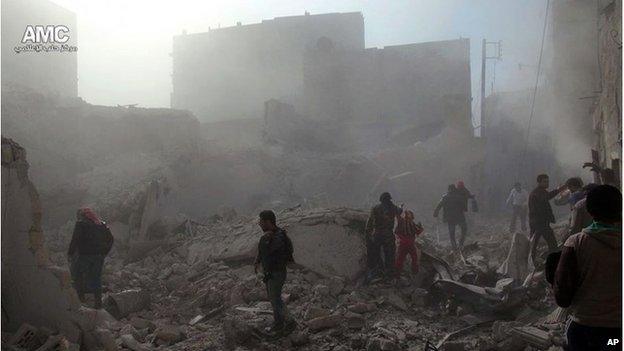Syria conflict: Barrel bombs show brutality of war
- Published

Activists said more than 70 people were killed when barrel bombs hit Aleppo in mid-December
For all the attention given to the issue of chemical weapons in Syria the fact remains that the overwhelming majority of deaths and injuries - especially civilian deaths and injuries - are caused by conventional weapons.
Many of them - like the barrel bombs reportedly used again in Aleppo by Syrian government forces during recent days - are home-made, relatively crude and totally indiscriminate in their impact.
The barrel bomb is essentially a large, home-made incendiary device. An oil barrel or similar cylindrical container filled with petrol, nails or other crude shrapnel, along with explosives. With an appropriate fuse, they are simply rolled out of a helicopter.
The first recorded use of such weapons goes back to late-August 2012.
Since then, weapons experts like the blogger Brown Moses and human rights groups have closely monitored their role in the conflict.
Large pipes were initially used but more recent examples have been more the size of oil drums. The weapons have been captured on video both in storage from a site overrun by rebel forces and also in at least one instance actually being rolled out of a government helicopter. Unexploded munitions have also been photographed.
Incendiary weapons which are defined as those intended to cause injury "through the action of flame or heat" are banned from use in populated civilian areas under the terms of the UN Convention on Prohibitions or Restrictions on the Use of Certain Conventional Weapons. While Syria is not a party to the convention, the campaigning group Human Rights Watch has insisted that the employment of these weapons constitutes a war crime and that those responsible should be held to account.
International efforts to condemn the use of such weapons have been stymied again this week with Russia reportedly refusing to back a Western-proposed text at the UN Security Council that would have condemned the Syrian President Bashar al-Assad for carrying out such indiscriminate attacks on civilian areas.

Rebels say government forces have been using barrel bombs in Aleppo for days
Why use them?
A spokesman for the US delegation reacted angrily, noting that the US was "very disappointed that a Security Council statement expressing our collective outrage at the brutal and indiscriminate tactics employed by the Syrian regime against civilians has been blocked".
This, of course, is consistent with Moscow's broader diplomatic approach. As one of the Syrian government's few allies, it has blocked any concerted UN Security Council action on Syria.
Quite why the Syrian government should resort to the use of these home-made munitions is unclear.
While in no sense accurate, they are probably easier to deploy from helicopters over built-up areas.
Hitting such targets with fast-moving fixed-wing aircraft would be more difficult.
Syria of course has also used a variety of Russian-supplied air-delivered cluster munitions which again are highly indiscriminate weapons when used in civilian areas.
The Syrian government's use of these types of munitions against its own population in rebel-held areas is a measure of the brutality of the conflict, which shows no sign of abating even as plans to remove chemical stocks from the country move into high gear.